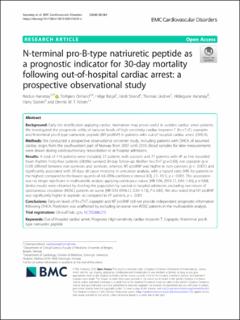| dc.contributor.author | Aarsetøy, Reidun | |
| dc.contributor.author | Omland, Torbjørn | |
| dc.contributor.author | Røsjø, Helge | |
| dc.contributor.author | Strand, Heidi | |
| dc.contributor.author | Lindner, Thomas Werner | |
| dc.contributor.author | Aarsetøy, Hildegunn | |
| dc.contributor.author | Staines, Harry | |
| dc.contributor.author | Nilsen, Dennis W.T. | |
| dc.date.accessioned | 2021-03-12T09:45:10Z | |
| dc.date.available | 2021-03-12T09:45:10Z | |
| dc.date.created | 2020-09-30T11:59:09Z | |
| dc.date.issued | 2020-08-24 | |
| dc.Published | BMC Cardiovascular Disorders. 2020, 20:382 1-10. | |
| dc.identifier.issn | 1471-2261 | |
| dc.identifier.uri | https://hdl.handle.net/11250/2733077 | |
| dc.description.abstract | Background
Early risk stratification applying cardiac biomarkers may prove useful in sudden cardiac arrest patients. We investigated the prognostic utility of early-on levels of high sensitivity cardiac troponin-T (hs-cTnT), copeptin and N-terminal pro-B-type natriuretic peptide (NT-proBNP) in patients with out-of-hospital cardiac arrest (OHCA).
Methods
We conducted a prospective observational unicenter study, including patients with OHCA of assumed cardiac origin from the southwestern part of Norway from 2007 until 2010. Blood samples for later measurements were drawn during cardiopulmonary resuscitation or at hospital admission.
Results
A total of 114 patients were included, 37 patients with asystole and 77 patients with VF as first recorded heart rhythm. Forty-four patients (38.6%) survived 30-day follow-up. Neither hs-cTnT (p = 0.49), nor copeptin (p = 0.39) differed between non-survivors and survivors, whereas NT-proBNP was higher in non-survivors (p < 0.001) and significantly associated with 30-days all-cause mortality in univariate analysis, with a hazard ratio (HR) for patients in the highest compared to the lowest quartile of 4.6 (95% confidence interval (CI), 2.1–10.1), p < 0.001. This association was no longer significant in multivariable analysis applying continuous values, [HR 0.96, (95% CI, 0.64–1.43), p = 0.84]. Similar results were obtained by dividing the population by survival at hospital admission, excluding non-return of spontaneous circulation (ROSC) patients on scene [HR 0.93 (95% CI, 0.50–1.73), P = 0.83]. We also noted that NT-proBNP was significantly higher in asystole- as compared to VF-patients, p < 0.001.
Conclusions
Early-on levels of hs-cTnT, copeptin and NT-proBNP did not provide independent prognostic information following OHCA. Prediction was unaffected by excluding on-scene non-ROSC patients in the multivariable analysis. | en_US |
| dc.language.iso | eng | en_US |
| dc.publisher | BMC | en_US |
| dc.rights | Navngivelse 4.0 Internasjonal | * |
| dc.rights.uri | http://creativecommons.org/licenses/by/4.0/deed.no | * |
| dc.title | N-terminal pro-B-type natriuretic peptide as a prognostic indicator for 30-day mortality following out-of-hospital cardiac arrest: A prospective observational study | en_US |
| dc.type | Journal article | en_US |
| dc.type | Peer reviewed | en_US |
| dc.description.version | publishedVersion | en_US |
| dc.rights.holder | Copyright the authors | en_US |
| dc.source.articlenumber | 382 (2020) | en_US |
| cristin.ispublished | true | |
| cristin.fulltext | original | |
| cristin.qualitycode | 1 | |
| dc.identifier.doi | 10.1186/s12872-020-01630-x | |
| dc.identifier.cristin | 1835502 | |
| dc.source.journal | BMC Cardiovascular Disorders | en_US |
| dc.source.40 | 20:382 | |
| dc.source.pagenumber | 1-10 | en_US |
| dc.identifier.citation | BMC Cardiovascular Disorders. 2020, 20, 382 (2020) | en_US |
| dc.source.volume | 20 | en_US |

